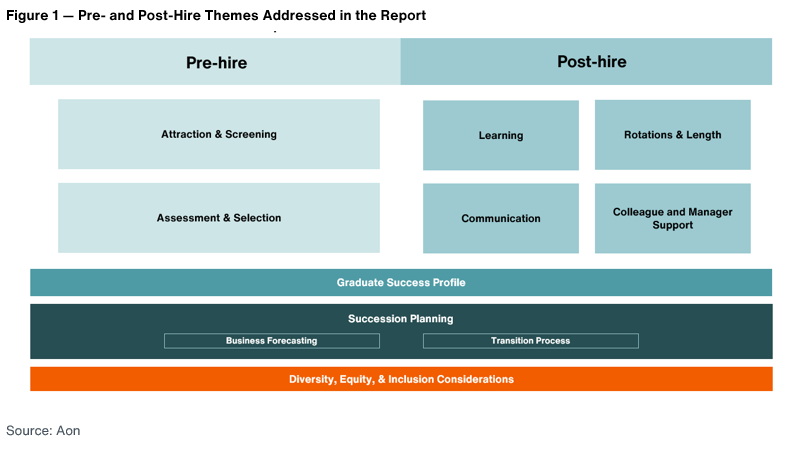With many investors now calling for racial equity audits, evaluating young talent through a yearly DE&I analysis of your company’s early careers programs is more important than ever.
As companies continue to look towards building a future-ready and diverse workforce to keep up with the evolving market, the importance of talent pipelines will remain front and center. As discussed in our recently published article, How Should Companies Respond to the Rise in Requests for Racial Equity Audits, new shareholder proposals on racial equity audits are becoming more and more common, as diversity, equity and inclusion (DE&I) continues to be a central topic for investors and proxy advisors.
Therefore, when establishing your future workforce, it’s essential to contextualize how well you are doing by partnering with an organization that can benchmark your success and approach. Without a proper audit of your early careers programs to help develop future leaders, it’s likely that you will fall behind on your firm’s diversity and inclusion goals.
This article explores how to approach a DE&I talent audit through early careers programs and the strategic use of available data.
Evaluating Your Early Careers Program
In order to attract the best young talent, companies should consistently evaluate and update their early careers programs. Effective and comprehensive programs will attract recent graduates to explore opportunities with your firm — from summer internships and apprenticeships to full-time rotational programs and more. A good early careers program expands young professionals’ experience, skills and interests, as well as the opportunities available to them in the workplace.
From a business standpoint, these programs additionally serve as a stable, highly effective source of diverse talent and allow firms to build a future talent pipeline. This is more critical now than ever for succession plans, as businesses are reporting an over 50 percent increase in turnover of their experienced hire workforce. An early careers program can also be very cost-effective, eliminating the need to hire new, in-demand talent at a high price.
Using Data to Assess DE&I in Early Careers Programs
Using data to address DE&I in your workforce is the key to measuring progress. It helps guarantee your early careers programs are fulfilling both your talent and diversity goals. In addition, the strategic use of data can help build an assessment process to ensure the right candidates are progressing and provides an understanding of the experience of various groups in your early careers program. Yet, in order to reach the full potential and benefits of your data, there are many challenges and gaps to consider:
- How rapidly and effectively are you turning the dial versus others?
- Are you comparatively good versus your industry?
- How do you benchmark DE&I metrics with externally available data and compare it against competitors?
- How do you decide what to adjust, iterate or tweak based on data-driven insights? Where does diverse talent fall off?
- What do your internal stakeholders want and are they in agreement? Is the focus on what the business needs?
- Are you taking a client-centric approach? Is your assessment process engaging and does it encourage people to apply?
On the whole, it is about collecting all sorts of data through surveys, focus groups, interviews, benchmarking and additional research to understand the gaps between the current state of the early careers program and where the organization wants to land.
The most challenging part of conducting a DE&I audit is knowing how you are progressing against others — and having this knowledge is critical. When managing an early careers program, be reflective and constructive. Empower improvements to your DE&I efforts through data and expert insights that will ultimately lead to improved business outcomes.
Case Study: DE&I Audit in Practice
Aon recently partnered with a national house-building firm to review its early careers program. The company was struggling to match new graduates with specific career paths within the business. There was a lack of understanding of best practice and what market leaders were doing. As a result, the company was experiencing poor engagement within the business for their early careers programs.
The Aon team conducted an internal analysis of the company’s resources. These data points included:
- job descriptions
- brochures
- application processes
- assessment approaches
- assessor capabilities
- rotational structure
- learning and development opportunities
- management
- communication styles
- overall colleague experience
- diversity stats to track progress and milestones
To collect information and applicable biodata, visionary interviews were conducted with senior stakeholders, as well as surveys with recent graduates, managers and other leaders.
In addition to using our own array of internal data points, externally, Aon analyzed top graduate employer practices and used market surveys and benchmarking data against established graduate and leadership programs — all practices that are most impactful in enabling DE&I. Our consulting team provided advice throughout the project lifecycle, as well as two in-depth reports with benchmarking, clear recommendations and prioritized next steps to support the firm’s early careers planning for both the project stakeholders and business.
The analysis looked at the end-to-end offering holistically, focusing on key challenges and pain points. We evaluated metrics using Aon’s robust benchmarks with a focus on the following pre-hire and post-hire points.

Next Steps
As early careers programs rise in importance, it’s critical to proactively perform a yearly DE&I audit to remedy any existing gaps and hold your firm accountable for the betterment of your people, values and future business.
To find out more on what you can do to align your early careers programs with your DE&I goals, please write to humancapital@aon.com.